It goes without saying that today is a somber day. No matter your connection to the events of eight years ago – whether you’re like Sherry and tearfully witnessed the towers falling firsthand or like me watching on TV, praying for family that worked in both NYC and DC – this date probably still shakes you. And while we were both fortunate that all of our loved ones escaped harm, our thoughts and prayers go out to those whose didn’t.
We’ve decided to use this date not only to reflect, but also to plan for the future. I’ve had emergency preparedness on the brain recently due to a project at work, through which I’ve learned that I’m actually in the minority. Most of us don’t stop to think about what we can do around our house to prepare for an emergency – whatever that disaster may be. And as much as I’ve been thinking about it at work, I figured it was time to see exactly how much I had put into practice at home. So here’s our own Emergency Supply Kit audit.
You can find the suggested Emergency Supply Kit list that we used to evaluate our preparedness on MakeAPlan.org. The first thing on the list is water – three gallons per person to be exact. We’re good here, I thought. We snagged a big case of bottled waters at least two years ago for this very purpose and stored it out-of-reach in the kitchen specifically for instances when we’re without clean water for a day or two. We’ve broken into a couple of times, but our supply is still pretty good. We’ll give ourselves a B+.
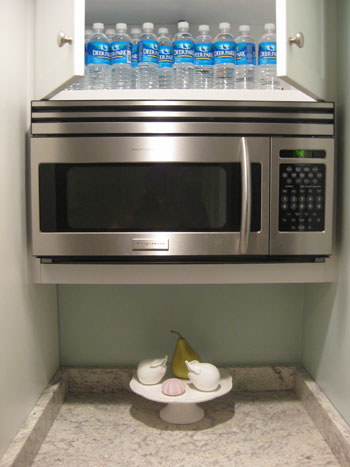
After water naturally comes food. Again, a three day supply of non-perishables is suggested. We’re lucky if we have a three day supply of non-perishable food within a day or two of our latest grocery trip, so we could stand to stock up on our canned food supply. But at least we’ve got a manual can-opener! I’d say that earns us a C.
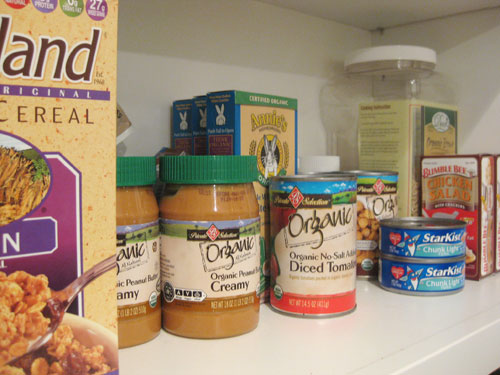
We do get an A+ when it comes to five days of pet food. We’re always sure to have a full canister of Burger’s kibble – mainly because the pet store that sells his food isn’t in our neighborhood so we always stock up when we go. And since Burger is a light eater (he’s 8lbs after all), five days worth of food doesn’t take up very much space.
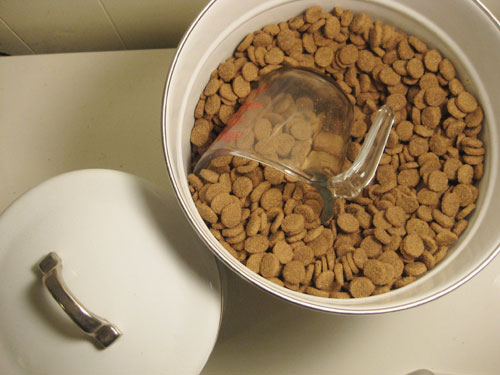
I was ready to give us an A+ in the battery-powered radio category, until I realized that the batteries in our guest room’s plug-in-with-battery-back-up radio are totally dead (and we’ve been relying on the cord). Did our grade just plummet to an F?
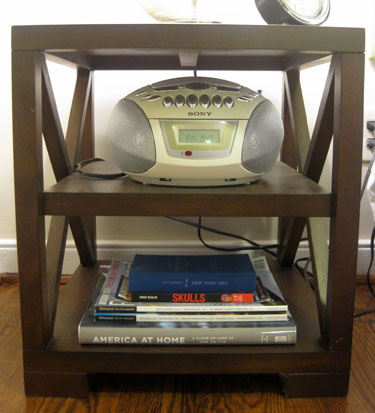
Nope! Because I realized that our shower radio is battery operated. Woo hoo!

We even have a few back-up batteries tucked away in a kitchen drawer. I’d say that gets us right back up into grade A territory on the radio front.
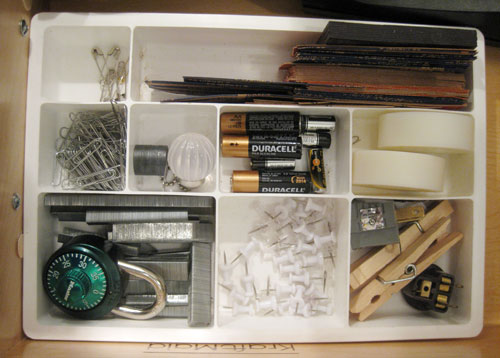
Though I’ll have to give us a B- on the flashlight front. While we’ve got a flashlight handy, we have absolutely zero back-up batteries for it.
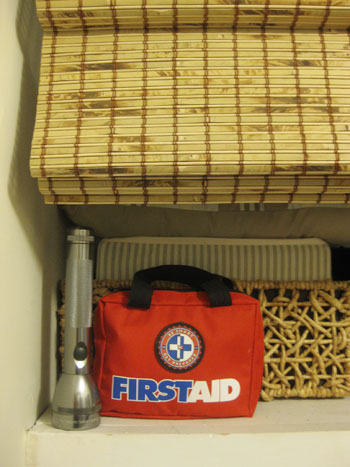
And while we’re also tempted to give ourselves a big round of applause for having a fire extinguisher and a real life first aid kit around the house, we must confess that it’s technically a Pet First Aid Kit. But it actually has pretty much all of the stuff we humans might need (just on the small side) so let’s call that one a B-.
Overall I’d say we get somewhere around a B for our home’s basic Emergency Supply Kit. Where do you guy stack up? Have you done any emergency planning or supply kit gathering? Got any other be-prepared tips to pass along? You can find out more from the official government folk at Ready.gov or MakeAPlan.org– and feel free to pass along anything else you learn on the subject. Oh and while we wish that all of you are ready for any emergency, here’s hoping that none of us find ourselves actually experiencing one anytime soon.
PS: If you’re in the Washington DC area, check out Capitalert.gov. It’s the project I’ve been working on at the office and it’s a way to get free emergency alerts sent to you via text message or email by your local government.
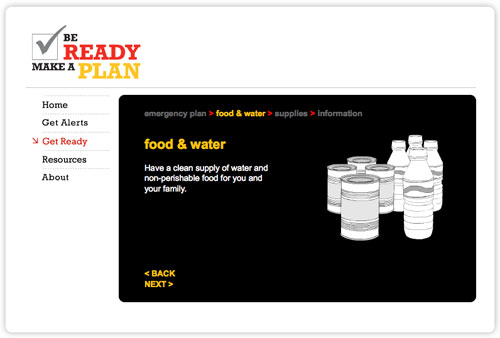

Lauryn says
We do not have an emergency home kit-so we get an F for that. BUT we do have emergency CAR kits in case we get stuck somewhere and our cell phone is out. Blankets, food, water, flashlight, crossword, umbrella, batteries, and jumper cables. Also the normal change your tire tools. We definitely need a house kit though! thanks for the post!
YoungHouseLove says
And thanks for the car kit pointer! We get a total F in that area, but it’s now on the to-do list.
xo,
s
Jenny @ Words On Wendhurst says
Let’s see, we usually have a case of water in our car, flashlights throughout the home (including a crank one, no worries about batteries!) and a crank powered radio. We have quite a bit of stocked canned food, and most of the elements of a first aid kit. I would say we are pretty set!
Lauren says
Thanks for this post!
Cheryl Joy says
It is so eye-opening to imagine Sherry actually saw the towers fall. I live in Florida and I was in a high school drama class when the news came.. we thought the teacher was “setting a scene.” The whole thing was mind boggling, really.
My fiance joined the national gaurd soon after the attack and joined the first unit headed out. He is returning in January. Today they are having a pre-deployment event for families of those leaving.
I really appreciate your post. It is easy to take our safety for granted. This is a great reminder.
-Cheryl Joy
Christine says
Living in S.Fla, a.k.a Hurricane Central, you would think that we would get an A in all of these categories. We always have a gallon or two of water stashed in the closet and an enormous amount of matches too, but due to the lack of hurricane action this season, our supplies are running very low. I agree though that we should be ready any time of the year. Looks like I’ll be stopping by the grocery store soon.
Kelly says
Hey Guys,
As a Red Cross employee, I am sooooooo excited to see you talk about preparedness on your blog. It is so important and is embraced by so few people. Another place you can find preparedness tips is here: http://www.redcross.org/flash/brr/English-flash/default.asp (Red Cross branded of course). Also, I love the Capitalert site, I will definitely share it with our volunteers, donors, and friends at the Alexandria Red Cross.
Cheers,
Kelly
Sevi says
Great post again guys!
And what about those flashlight & cell-phone charger & radio combos, which you crank and get the energy without batteries, like this one for instance (http://www.amazon.com/Campo-Crank-Flashlight-Phone-Charger/dp/B000FRZ8XM)?
We just bought one similar but I need to make sure it works before an emergency occurs! I don’t know how much cranking you need to get it work.
Elaine says
I’m in Houston and learned a few things about emergency supplies after Hurricane Ike last year and Tropical Storm Allison eight years ago. 1. C and D batteries, required by many flashlights and boom boxes are practically impossible to find at crunch time. Stores just don’t stock as many of those sizes as they do AAs. Now I only buy flashlights that take AA batteries. 2. If you can, dump the bottled water you have had for two years and get a fresh supply if you’re concerned about chemicals in the plastic leaching into the water. 3. It takes 24 hours for an icemaker to fill up, so start making ice a few days ahead of a storm. 4. Make big chunks of ice using half- and one-gallon tubs. 5. Cook any meat and seafood you have in the freezer and refreeze. Then you can eat it without needing to cook it when there’s no electricity and you’re totally stressed out. 6. Do all the laundry before the storm hits. You’ll need the clean clothes. We got our electricity back two days after Ike hit but most of our neighbors didn’t get theirs back for two weeks. Our house became the local laundromat!
Love your site and all the great ideas! Keep ’em coming!
Juliet says
Great, great post. You two are always on point. Thanks for the sensitivity and the motivation!
lrw2a says
Another thing that’s often recommended (we live near DC, so we are perennially on high alert) is a sufficient amount of cash for anything you might need to buy in a hurry (food, gas, etc) – most of us use credit cards day-to-day and get cash from ATMs. Without power, neither system is available.
Also, have it in small bills – $1’s and $5’s, so you don’t have to get change from anyone.
Jen Z. says
what a great post. thanks guys. we are def. not prepared for an emergency, well at least not in the food department or battery department. We will have to work on that. Thank you!
Joann says
Living on the coast in VA I’ve got all but a formal first Aid kit. The ice recommendation is great, but don’t forget to gas up before the storm and get some cash. Found out with Isabel a few years ago that those things don’t work when power is out.
I was amazed at how many restaurants managed to open and sell out the food they had on the premises, though.
Alison Moreno says
I have always been trying to build our emergency kit and my son has been drinking a gallon of apple juice at least once a week and now that I have a one year old daughter we are going through gallon jugs of juice twice a week. I started cleaning them out a few years ago and now we have over 50 gallons of water. We store most of it under my daughters crib but you can find them in the backs of our closets and under sinks. I was told that a person in an emergency would need a gallon of water a day for more than just drinking water. So now we have 4 people in our home, we need a lot of water. A friend of mine made a book of emergency supply information and recipes to use with canned foods and dried foods. Its an amazing book.
Christin says
Thanks for the grest post on emergency preparedness. It’s so important, yet I think my husband and I get a failing grade. It’s really something we need to discuss and plan for. Thanks for the reminder and helpful information.
christina in nh says
You should grab one of those hand crank radio/flashlight thingie jigs! Then you’d never have to worry about batteries again. L.L. bean makes an excellent one, and I believe they only cost around fifty dollars. Would make a great gift! I personally always forget about the water thing, but I do try to have some camping gadgets on hand. They are portable and lightweight and essential if you have to leave your house.
Pamela says
When storing water for an emergency – just buy the gallons from the store. If you wash and refill old bottles you will get some sort of bacteria in there that is going to grow over the storage time. Ditto Elaine on rotating your water stock after a couple of years, not just the plastic leeching, but the chance of bacterial buildup.
We also live in hurricane territory and I’m slowly working on our emergency kit. One thing we did do in the rush of evacuating from Ike last year was to take pictures of ALL of our belongings in case you need to document things for insurance. And then update it every year (which is one of those things I need to do).
Karen says
Thanks for the info. I do have a few gallons of water, but the other stuff that I do have is just by accident. We could probably live for 3 days on the food we have in the house. One thing that we have that I love is a crank powered flashlight (im sure there is a more correct term for that). Someone gave it to us for Christmas for camping. It also has a radio on it. It doesnt use batteries. You just crank this little handle 20-30 times and it works for a few hours. I also have a small lantern and matches in case the power goes out. We need our light!!!
Kate says
Great information, thanks! Unfortunately, my husband and I get a failing grade. That is super sad, as my parents were so good at it! I grew up in the Caribbean where we got multiple storms a year, with power out for months at a time. With hurricanes close and limited island supplies, stores turned into riots, so you always had to be prepared.
Just to add one more tip about water – we always filled our bathtubs and washing machine with water right before the power was shut down. Then by pouring a bucket into the back of the toilet, you could still flush!
Cathy says
Is that bottled water safe to drink after sitting around for two years? You might want to rotate it more often. I think the recommended guideline is like 4-6 months. And since I know you don’t like plastic, you might consider just saving filtered tap water in recycled glass bottles. Anything that previously held liquids should be safe to use. You can run them through your dishwasher to “sterilize” it. Those big gallon jugs of apple cider that you see in stores this time of year are great. Bottled water isn’t necessarily filtered. A lot of time it is just tap water, so it’s not necessarily safer to drink.
YoungHouseLove says
Yeah, we hate bottled water (and plastic containers in general) and agree that ours is probably past it’s prime at almost two years old. The new plan is to save large glass juice bottles a la Alison and fill them with our filtered tap water to create a lot less waste than switching out our bottled water supply. That way we can dump them out and refill them from time to time to avoid bacterial build-up, and even toss the bottles in the dishwasher to clean them since they’ll be non-leeching glass. Thanks so much for all the amazing tips and ideas guys! Keep them coming.
xo,
s
Katie C says
With regards to the flashlights sans backup batteries, I’d definitely reccomend getting an LED flashlight which operates through a crank! I bought one several years ago just because I love the idea of not having to replace (and throw away) batteries, and it has come in handy on more than one occasion. It helps the environment, too!
Katie C says
I forgot to mention that it cost under $20!
steph anne says
Wow, you guys are definitely prepared! And we’re not in ALL areas… we definitely get a big F. But I really do want to do this and it’s definitely going to happen soon. Thank you for bringing this to our attention! :)
Rachel says
There is one thing you forgot that I would highly recommend. My brother-in-law and his family was hit by a hurricane completely unprepared. No food, no water, no cash and an estimate of two weeks before electricity would be restored. They had to scramble to decide how best to deal with three small boys who were justifiably scared. My father-in-law was the one who pointed out to them they should have had a plan. While having supplies is great, having a plan can be just as good. In this case, they had to go into debt to pay for plane tickets to Colorado.
A plan can be anything from a friend across town you agree to contact in case communication fails, enough cash reserves to pay for a plane ticket, or a meeting place for the family. The plan should suit the family. For example, my area is prone to flooding in the winter. I know that if a flood is coming and may force us to leave our home unexpectedly, I can contact a friend in the town my husband works in and head to a nearby coffee shop that is guaranteed higher ground. So always have a plan.
Cecelia says
Costco has a great emergency food kit that comes in a plastic bucket.
It contains 274 dehydrated meals, for $84.99.
At two meals/day, that would feed two people for over 2 months.
The kit has a shelf-life of 20 years.
You can find it online.
Of course, you’d have to consider the water usage needed to reconstitute these meals, in your water supply storage plan.
I like the 2 1/2 gallon jugs of water that come with spigots. They generally cost less than two- 1 gallon jugs.
I started preparing for a major disaster when gas supplies got so low a couple of years ago.
Many people in my neck of the woods did not have enough gasoline in their cars to drive to the store for food!
Nothing like THAT and seeing “NO GAS” signs at service stations to bring it home to you how precarious things really are today.
I started to think about what would happen if gas was rationed to the point that stores couldn’t be stocked as often, or as well.
This isn’t paranoia, it’s a realistic concern given the state of world affairs.
I’m fortunate in that I need be concerned for preparing for only myself and my husband (my daughter has provisions), but people with children to feed have even more reason to begin preparing by budgeting and setting things aside for a disaster.
If you have a big family, don’t get discouraged, do it a bit at a time. There are lots of nonperishable cheap canned foods that you probably don’t choose to buy for your family now (because they aren’t the healthiest stuff in the world) that would a god-sent in an emergency.
Start now.
Loren says
After my friends parents lost nearly everything in a recent fire I would also suggest having a PLAN. Know what you are going to do if there is a fire or an earthquake. Know where important files (a fireproof safe if possible), know where a pet carrier is and be able to get to it quickly , know where electricity, water and propane shut off valves are if you need to get to them, have a place a safe distance away from the house to meet each other if you get separated. Go over this information with your family members, make sure children know the emergency numbers for your area.
Yvonne says
I live in Germany, so not many emergencies here. But I would think, it is more useful to keep all those things you might need in one place. Maybe in one of those big metallboxes. In a case of emergency you might not have the time to grab all bottles of water, batteries and dog food.
That way it is also stored away and you won’t take it thinking: I’ll go to the store tomorrow, then I replace the batteries.
And just like your filter for your water you can make a note in your calender to replace water and food, that might not be good anymore.
Stephanie says
Last summer I lived in an area where we had a lot of tornado warnings and power outages. So, I bought myself a handy dandy battery powered and crank powered flashlight with a built in radio and phone charger. It is soooo handy and if you ran out of batteries, all it takes in a few minutes of cranking to get a bright light and emergency radio.
http://www.radioshack.com/product/index.jsp?productId=3696287
I got mine at Target for cheaper than what is listed on the Radio Shack site, but I couldn’t find the product on the Target website.
Katrina says
I work at a very large university that is making sure its students, faculty and staff are prepared should the Swine Flu thing explode during the regular semester. In this first week of class the preparations are already coming in handy as the health center had been handling a larger than normal number of flu-like cases (though they’ve told us its no need to panic, as it seems the seasonal flu is just hitting the campus hard).
At any rate, we’ve been getting updates from the campus about how to be proactive and it includes these helpful tips for your home kit:
“While you are well, create a “Flu Kit” by purchasing a non-aspirin fever-reducing medication (Tylenol, Advil, or similar brands), a thermometer, a decongestant, tissues, hand sanitizer, some surgical masks, soup, crackers, and tea or Gatorade type beverage.”
I thought I’d pass these recommendations on to you guys so you can include them in your emergency preparedness checklist. With the flu season coming up and all the extra paranoia it will bring this year, it’s important to have this stuff on hand so you don’t have to run out to the store and risk spreading it to others (or at least avoid getting the “ew, don’t you dare cough on me” look from other shoppers).
Lauren says
Vital reading for being mentally prepared for an emergency — an aspect I’d never considered. Fascinating articles:
http://www.time.com/time/magazine/article/0,9171,1810315-1,00.html
http://www.time.com/time/magazine/article/0,9171,1053663-1,00.html
Yvonne says
Don’t forget the kids, those of us that have them should add in some extra diapers. Baby wipes are also great for washing up when there is limited or no water. I also agree with the family plan idea, families may be in separate locations in the event of an emergency and knowing where to meet would make the situation less stressful. Thanks for the post, and I love your website!
Laura says
We get a D-. We have a first aid kit. That’s it. Pretty bad when you live in a hurricane-flood zone, huh?
I guess this is just another way you guys give your readers an “I never thought of that” moment. :)
Katrina says
Also, I forgot to add the important note that followed the recommended list:
“Please note: Some people feel it necessary to wear masks when there is an outbreak of a virus. Please be aware it is most effective for those who are sick to wear a mask to keep from spreading germs through coughing and sneezing. Wearing a mask when you are well does little to keep you from catching a virus.”
heather s. says
I agree about the crank-radios/flashlights. You won’t have to worry about batteries! I think someone else mentioned this but while you have a great supply going it makes sense to store them in one place if possible. I read a blog entry from someone like a year ago who put together backpacks for each family member with a lot of these goods. I have a large rubbermaid tote with emergency supplies so practically everything I need is in one place so I don’t have to hunt for it.
I also second (or third!) the emergency kit in the car. Growing up in the UP of Michigan, we learned to always keep emergency things in the car including a blanket (never know when your car will die in the harsh winters we have up north!) and snow shovel besides your usual fare.
Chrissy says
Sherry and John, thanks for posting a relevant and completely appropriate post for 9/11. I love how you guys keep politics and controversy out of your blog when it has the tendency to creep in everywhere else out there, and I think your topic touches on the day and respectfully acknowledges the lessons learned.
Jamie says
Great advice for an emergency kit. We live in California earthquake territory and fire territory so every few months we try and audit if we’d have enough supplies in case of an emergency (thanks sams club for tons of canned food and water and the kick ass crank radio we got there).
I second (maybe third) having a clear PLAN that is communicated and agreed upon by all family members, we even have our written down and posted near the calendar just in case I lose my head and forget in an emergency. We actually have two plans, one for general emergency (like an earthqauke) and one in case we need to evacuate (like a forest fire). Also make sure your plan includes a meeting place in case cell phones do not work and you are seperated.
Thanks for this important post. I need to check on everything again as we are just entering fire season here in California.
Kelly S says
Although I haven’t started on this project, it was suggested to me to have a backpack for each memeber of the family with a 3 day supply of food, clothing and medications. If you have to be evacuated from your home, you just grab it and go. Don’t forget to rotate clothes for season and if you have children, for growth. Pack granola bars and other non perishible items in each persons backpack.
Medications – someone told me you can get 1 month ahead from your pharmacy for instances like emergency prepardness.
Family binder – we keep all of our social security cards, birth certificates, military records, childrens vaccination records and financial info in a binder. In an emergency, I know exactly where it is and it’s on my list of things to grab incase of an evacuation.
Great ideas everyone!
Elisa says
you guys are so cute. i wish my kitchen supply drawer was as organized as that. we have the little drawer divider, like you guys, but there’s uhhhh… not really anything in it? just a pile of stuff scattered AROUND it. haha.
anyways i’ve been thinking lately that i need to put together an emergency kit. we’re in hurricane/stormy season here in FL and the power goes out like, once a week? and let’s just say if any emergency came around, we’d be on the hungry side. thanks for the motivation to finally get my act together!
Kelly S says
One more thing, it sounds kind of cheesy in this day and age of advanced technology but we also have a set of walkie-talkies so that if we are separated we could still communicate.
Pamela says
The walkie-talkies reminded me of another – teach your older family members how to text message. In emergency times when phone lines are jammed texts often get through when calls fail. My mom learned the hard way during Katrina and is now proficient enough to get basic messages across.
corinne purnell says
Hey thank for posting this, it is super important that people are prepared in case of emergency. Just thought i would let you know the government actually suggest that each person has a three month supply of food, water, and other neccesittys, like meds, personal hiegine products etc..
Elisa says
just so you guys all realize, often when there’s an emergency (especially the natural disaster kind) cell phone towers get affected. meaning, ZERO reception – so that everything you rely on your phone for is GONE.
i saw a few comments about phone calls, texting, etc and if local towers are damaged, all of that is useless. learned this all firsthand during Hurricane Charley/Charlie/whatever.
YoungHouseLove says
Hey Elisa,
Very good point! In the days after September 11th we all lost cell phone usage in the city, all subways pretty much stopped running, nearly all of the bridges and tunnels were closed, and land-line phones were disturbed as well. Talk about scary! It’s a great reminder to store important family and emergency numbers on paper somewhere, just in case your cell goes dead or isn’t functional!
xo,
s
Jennifer says
As an ex-Red Cross staffer, I would also like to recommend a portable kit. While some emergencies require us to shelter in place, many emergencies require us to leave home (fire, flood, tornado). For those that require us to leave, often it’s in short order. So, either know where everything is and have a large bag ready to go…or better yet, have a portable kit. A large tupperware container or an unused suitcase with wheels filled with your basics is a great start.
Another tip for parents or pet owners, pack away something that will provide entertainment/distraction. That might be a deck of cards, books, crayons or a stuffed animal.
And, I wouldn’t feel right if I didn’t suggest contacting your local Red Cross to learn First Aid and CPR. You never know when you are going to need it!
Val says
We get a lot of tornadoes in our area, as well as the occasional inland-moving hurricane. Plus, I work at a bank, which means we talk a lot about emergency preparedness (banks are required by the FDIC to have continuity plans in place for emergencies). There are a lot of great ideas here.
Elaine, my mom always started filling clean milk jugs up with water and stuffing them in the freezer when a storm was coming. Besides thawing for drinking, you can use them to keep food in coolers cold. And she always filled up the bath-tub, too.
We keep our emergency stuff right next to all our camping gear, which I think is really handy. Sleeping bags, campstoves, head-lamps, rain-jackets, even tents and tarps are all useful for emergency situations. And if we come home from a camping trip with some extra dehydrated meals that didn’t get eaten, I can just chunk them in the emergency box. We also keep a flashlight in each bedroom, so nobody is stranded. I also keep an extra leash and collar with the emergency dog food; I’m paranoid about not being able to find one when I might need one most. We need to do better about keeping cash around…it’s so hard to do! We need to just hide it from ourselves.
Good post. Good stuff to be thinking about.
Sarah says
This is a great post. I think it’s probably a bad thing that I rely on my college to take care of me if an emergency were ever to occur because I live in an on-campus apartment. I think I should probably look into these things, though, just in case. Luckily, a lot of the food I buy is non-perishable so that’s good, but other than that I have nothing. I failed miserably! :( Thanks for making me aware of it, though!
ghazal says
are those yummy auntie b’s bunny grahams i see hiding in the back of that cabinet? if so, i give you an A++! those darn bunnies are DELISH!
Cecelia says
Comment by StephanieNo Gravatar on September 11, 2009 @ 12:22 pm
Thank you so much for this link!
Jen says
I definitely agree with others who have suggested the hand crank radios and flashlights. We keep these in our cars and house. We also keep wood and matches on hand for heat in the winter. We keep extra water and gasoline on hand in case of emergencies, food and manual powered items such as the can opener that you mentioned. We even have a motercycle stored in our garage that someone was getting rid of. While neither of us actually has a motorcycle license nor really knows how to operate one very well, I’m sure we would both learn really fast if an emergency should arise that wipes out gasoline/oil supplies… We also have car kits with blankets, water, matches, flares snacks, tools, jumper cables and first aid kit.
Meghan says
Great ideas everyone! Another aspect of emergency preparedness is knowing what you own. It can be tough dealing with insurance companies after something like a fire or flood that wipes out your possessions. There’s a really easy-to-use FUH-REE home inventory program that I heard about on a public radio show (Marketplace Money). I haven’t finished ours (it’s one of my resolutions for this year – I’d better get crackin!) but it’s pretty user friendly. Since we got married a couple of years ago, I still had a couple of our registry print-outs lying around, which has been VERY handy for remembering things like small appliances that I NEVER would have remembered after-the-fact, filling out insurance forms.
Here’s the story from Marketplace: http://is.gd/39Wta
Here’s the inventory system they link to, which is free from the Insurance Information Institute: http://www.knowyourstuff.org/iii/login.html
-Meghan
**I have no affiliation with either Marketplace or the III, except I like their advice!
nell ann says
Being in a family of emergency workers, one of the tools we use most are headlamps. You can get them in most big chain or sporting goods stores for less than ten bucks. My husband and I keep one in our nightstand and there’s also an extra in the kitchen and one in each of our cars. People don’t often realize how hard it is to do things in the dark with only one hand, especially if you’re caring for pets or children who need extra attention.
Kathleen Shannon says
I’ve heard that you should keep all of those things together in a large bin (like a big rubber trash can) in the garage in case you need to pile it all up in your car at once. You should also have all pet records (and meds) on hand in case you need to take Burger with you to a shelter in the event of an emergency.